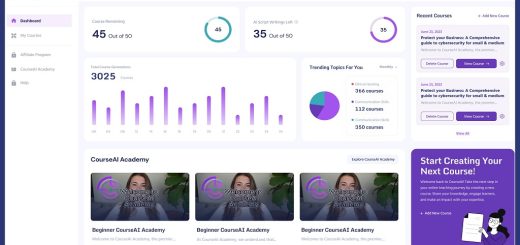Optimizing Supply Chain Operations in E-commerce With AI
Hey there! E-commerce has exploded in popularity over the last decade. Online shopping is now a massive industry, with global e-commerce sales expected to reach $7.4 trillion by 2025. But with great sales comes great logistics challenges. Successfully managing inventory, shipping, returns, and all the other supply chain operations for an e-commerce business can be daunting. This is where artificial intelligence (AI) and machine learning come in. These cutting-edge technologies are revolutionizing supply chain management and enabling e-commerce companies to optimize their operations.
We’ll look at how AI and machine learning can be applied across the e-commerce supply chain to increase efficiency, reduce costs, and provide a better customer experience. Whether you’re just starting with an online store or running a large e-commerce enterprise, integrating AI and ML into your operations can give you a significant competitive advantage. Let’s dive in!
Demand Forecasting with AI
One of the most challenging aspects of e-commerce is predicting consumer demand. It’s frustrating when you stock out of a hot item right when demand spikes. And it’s wasteful to overstock products that end up sitting unsold in the warehouse. AI-powered demand forecasting uses data like past sales, seasonality, promotions, and even weather patterns to predict future demand with uncanny accuracy.
Machine learning algorithms examine historical data to detect patterns and correlations. As the AI model processes more data over time, the forecasts become more precise. AI can even generate product-level demand forecasts accounting for influenced like color, size, and product configuration. Rather than relying on human analysts to crunch the numbers in spreadsheets, AI handle complex demand modeling automatically. This ensures you have just the right amount of inventory to meet demand without overstocking.
For example, if you sell winter coats online, the AI could determine that black coats in size large are more popular in cold climates in January. The system can then recommend stocking more of that specific product variant to match projected demand. Pretty cool (pun intended)! With AI-powered demand forecasting, you can say goodbye to dead stock and lost sales due to stockouts.
Intelligent Inventory Management
Closely related to demand forecasting is inventory management. An e-commerce business needs real-time visibility into inventory levels across their entire supply chain network. This includes stock levels in warehouses, stores, 3PL locations, and in transit. With millions of SKUs to track, this is a monumental task without AI.
Inventory management AI aggregates real-time inventory data across the entire supply chain. It tracks stock levels across locations while accounting for pending orders and deliveries. The system automatically detects potential stockouts before they happen based on demand forecasts. You get intelligent recommendations for inventory replenishment and transfers to avoid running out of key products.
Machine learning algorithms also help optimize safety stock levels. Safety stock is the buffer inventory kept on hand to prevent stockouts in case demand exceeds forecasts. AI evaluates historical variances in demand to determine ideal safety stock levels for each product. This minimizes excess inventory while still avoiding stockouts. The AI can even adjust safety stock dynamically based on real-time supply chain disruptions.
With AI overseeing inventory, e-commerce businesses can deliver consistent product availability and on-time order fulfillment. Customers get what they want when they want it, leading to increased satisfaction and retention. And companies reduce excess inventory carrying costs by right-sizing stock levels dynamically. It’s a win-win!
Smart Warehouse Automation
Warehouses are the engine that powers e-commerce supply chains. But traditionally warehouse operations have been very labor-intensive, relying on armies of workers to pick, pack and ship orders. Now AI-enabled warehouse robots and automation systems streamline fulfillment to new levels of speed and efficiency.
Autonomous mobile robots can handle material transport and inventory scanning chores. This automates the mundane walking back-and-forth that consumes worker time. Intelligent picking systems guide workers or robots to pick items in the optimal sequence. This reduces travel distance and pick times. Automated packaging systems customize boxes to order dimensions to reduce materials waste and shipping costs.
AI also schedules and optimizes all warehouse tasks in real-time. Machine learning algorithms assign work based on current priorities and labor availability across shifts. The AI tracks worker productivity to spot bottlenecks as they occur. It can even reorder tasks on the fly in response to unexpected delays or absences. This level of supply chain execution intelligence maximizes labor productivity and on-time order shipment.
Additionally, AI tracks trends across warehouse KPIs like peak throughput, utilization, and order accuracy rates. By monitoring warehouse performance, the AI identifies opportunities for further process enhancements. It can recommend modifications like reallocating stock across pick zones to increase efficiency. With AI overseeing warehouse fulfillment, e-commerce businesses can scale operations efficiently to handle spikes in order volumes.
Optimized Transportation Management
For e-commerce sellers, transportation is often the highest supply chain cost. Shipping packages to customers quickly and affordably at a profit can be challenging. AI-powered transportation management systems (TMS) optimize delivery logistics to control these costs.
The TMS analyzes shipment data and evaluates routing options across all carriers. It provides decision recommendations that balance delivery speed, cost, and order priority. For example, it may advise using overnight air shipping for high-priority orders and consolidated ground freight for low-priority items. AI shipment planning optimizes container utilization, mode selection, and routing to minimize expenses.
AI also helps create optimal delivery routes and schedules for the private fleet while adhering to constraints. This reduces miles driven and fuel costs. Machine learning examines traffic patterns in different geographies and forecasts upcoming congestion. It then suggests dynamic routes to avoid delays during crunch times. The AI tracks real-time location data from drivers to reroute them around accidents or construction on the fly.
At the strategic level, transportation AI analyzes trends like average package weight and dimensions. It identifies opportunities to adjust inventory allocation designs across facilities to optimize transportation lanes. TMS AI also monitors carrier performance on delivery timeliness, accuracy, and loss/damage rates. This enables informed carrier selection and contract negotiation. With an AI-powered TMS, e-commerce companies gain significant control and visibility over transportation costs and operations.
Minimizing Returns With AI
Returns are a headache for e-commerce sellers. According to the National Retail Federation, around 10% of all online orders end up returned. Handling, restocking, and writing off returned merchandise is expensive. AI-powered returns reduction solutions leverage data to minimize returns upstream.
For example, machine learning algorithms evaluate past returns data connected to customer demographics and purchase behaviors. The AI can identify customer segments with a higher likelihood of returning items. When these customers place an order, the system can prompt special messaging to set appropriate expectations. This reduces subjective returns resulting from unrealistic expectations or misunderstandings.
AI also analyzes product return data to detect reliability issues or sizing problems. It can flag products with high return rates to engineering teams for redesign. AI identifies ambiguous product descriptions and suggest tweaks to provide missing details that cause confusion. By detecting patterns in return drivers, AI enables both customer and product changes to reduce returns volume.
When returns do occur, AI speeds up processing. Computer vision systems quickly evaluate item condition to determine optimal disposition. For products eligible for resale, machine learning prices them based on historical demand trends and similar item performance. Intelligent re-stocking systems slot returned items back into available inventory slots. With help from AI, e-commerce sellers can tighten the returns loop and recoup losses.
Enhanced Procurement With AI
E-commerce businesses need to procure goods from suppliers at optimal prices to maintain profit margins. But fluctuating market rates, long supplier lead times, and bulk order requirements make this difficult. AI-enabled procurement solutions help navigate these complexities to gain sourcing advantages.
Data-driven supplier benchmarking helps assess suppliers on total cost, quality, lead time, and reliability. This enables informed supplier selection when securing inventory. Machine learning analyzes commodity markets, weather, political changes, and other external factors that influence material pricing. The AI can forecast price fluctuations and identify opportune times to lock in rates.
When ordering, AI can optimize purchase orders across suppliers while incorporating quantity discounts and transportation costs. It also helps plan order sequencing over time factoring in production capacities and lead times at each supplier. The AI tracks incoming order deliveries and flags potential delays or short shipments in advance to take corrective action.
With procurement AI, e-commerce companies make supplier and purchasing decisions that balance costs, risk, and service levels. They gain resiliency against supply uncertainties and market changes that impact material costs. The supply chain becomes truly intelligent, automatically adapting procurement patterns to optimize results.
The Power of an AI-Optimized Supply Chain
As we’ve seen, applying AI across e-commerce supply chain operations drives significant improvements in efficiency, visibility, and resiliency. When all the pieces work together – demand forecasting, inventory management, warehouse automation, optimized logistics, minimized returns, and enhanced procurement – the benefits multiply exponentially. Companies gain comprehensive real-time visibility while avoiding costs from overstocks, stockouts, and wasted handling.
AI turns all the complex, disjointed supply chain components into a coordinated, intelligent system. Problems get detected faster, and disruptions become more visible. The AI can take corrective actions and route workarounds before delays even reach the customer. It optimizes all processes dynamically while balancing service levels and costs in real-time.
The supply chain becomes a competitive differentiator that provides an immersive, frictionless customer experience. Customers get exactly what they want, when and how they want it. E-commerce businesses can then focus less on supply chain fire drills and more on devising creative products and solutions that captivate customers. The potential of AI-powered supply chain optimization is limitless. The future is here – embrace it!
Frequently Asked Questions
How quickly can I see results after implementing AI for supply chain optimization?
Most companies see significant improvements within 3-6 months after deploying AI. The machine learning algorithms require some initial data to train the models. Over time, as more data gets ingested, the AI forecasts and recommendations become more accurate and robust. Within 6-12 months, companies achieve optimized levels of automation, efficiency, and flexibility powered by AI.
What supply chain KPIs typically improve the most with AI?
Significant improvements can be observed in forecast accuracy, inventory costs, shipping costs, backorders/stockouts, and on-time shipments.
What AI capabilities provide the fastest and most significant impact?
Demand forecasting and inventory management AIs tend to provide the fastest, most substantial benefits. Aligning supply closely to demand improves service levels and reduces waste across the entire supply chain. Transportation management AI also brings quick cost reduction wins through optimized logistics.
How can I get started with supply chain AI? What are some key best practices?
Start with a focused pilot project in one supply chain area, like forecasting for instance. Assess AI solution providers and select one that demonstrates rapid time to value. Emphasize data integration to feed diverse datasets into the AI engine. Monitor KPI impacts closely. Scale successes to other supply chain processes. Enlist change management support to align staff behind AI adoption.
How does supply chain AI integrate with my existing ERP and WMS systems?
Leading AI solutions platform-agnostic. They can ingest data from any source system through APIs and integrate predictions and insights back into your existing workflows. Most don’t require rip-and-replace implementations. The AI becomes a connective intelligence layer that enhances your core backbone systems. APIs and microservices enable smooth interoperability.
Last Words
There you have it – a comprehensive overview of how AI and machine learning can optimize end-to-end supply chain operations for e-commerce businesses. Implementing AI leads to increased sales, reduced costs, improved efficiency, happier customers – and ultimately higher profits. By leveraging the cutting edge technologies of AI and ML, your supply chain can gain a true competitive advantage to drive your e-commerce success to new heights.
The future of commerce is data-driven, intelligent, and automated. With AI as the brains behind your supply chain, you position your business for scalable growth and resiliency. Ecommerce web development providers can revolutionize online businesses by integrating AI into their platforms, eliminating supply chain constraints, unlocking untapped potential, and enabling a superior customer experience. As consumer expectations and global competition escalate, embracing AI-powered supply chains becomes a necessity rather than a luxury. The time is ripe to usher in the AI revolution and elevate ecommerce to new heights.















